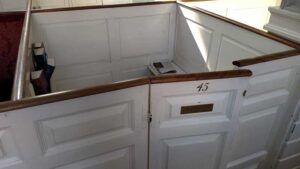The People in the Pews: Lynde Walters, Jr.
By Mark Hurwitz
Q. How is the Old North Church tied to the production of newspapers in the 19th century?
A. Through a man named Lynde Walters, Jr., who attended Old North and owned pew #45. (His father, Lynde Sr., also attended the church and served as a junior warden in 1804.)
 So who was Lynde Jr.? Like many upstanding Bostonian boys of the time, he attended Harvard College and graduated in 1817. His career took a prominent turn when in 1830 he was hired as the editor-in-chief of the Boston Evening Transcript shortly after its founding by Henry Dutton and James Wentworth that same year. He remained its editor until 1840.
So who was Lynde Jr.? Like many upstanding Bostonian boys of the time, he attended Harvard College and graduated in 1817. His career took a prominent turn when in 1830 he was hired as the editor-in-chief of the Boston Evening Transcript shortly after its founding by Henry Dutton and James Wentworth that same year. He remained its editor until 1840.
The Boston Evening Transcript was first published as a “penny press” newspaper. Penny press newspapers were called such because it cost only a penny to purchase at the local newsstand. Production was extremely cheap as well, and news became easily accessible to the average person.
Although penny press papers often included gossip and coverage of the seedier side of city life, the Boston Evening Transcript kept it classy with coverage of literature and theatre. In fact, Lynde Jr.’s sister Cornelia was its first theatre critic.After Lynde Jr. died in 1842 from complications from inflammatory Rheumatism, Cornelia became its editor, the first woman to become the editor of a major American newspaper.
After his death, Lynde Walter, Jr. was laid to rest in tomb #8 in the Old North Church crypt alongside his family members.
The Boston Evening Transcript ceased operations in 1941.
